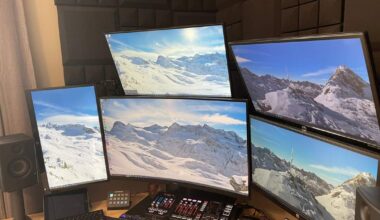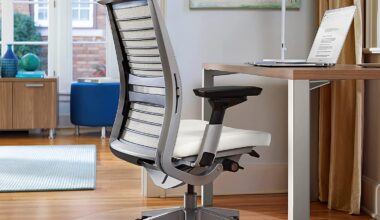Everyone has that awkward corner in their house that they rarely ever use.
No matter what you do to hide it, it will always stick out like a sore thumb until you decide to turn it into a usable space like a home office!
Convert an Awkward Corner into the Home office with an appropriately sized workstation (Desk, chair, and shelves). Next, decide on adequate ambient or task lighting and decorations for your home office.
The awkward spaces like under the staircase, wall recess, or between the wall and column are useless for anything else.
Turning them into a functional home office will prove the best choice because you will set up an office without renting another space.
Read on to discover how to convert an awkward corner into a functional home office.
Table of Contents Show
Why Convert an Unused Space into a Home Office?
Using awkward corners in the home for the office can be the best solution to an otherwise dreadful space.
Moreover, people find it hard to concentrate on their work from home, which is made worse by a lack of a proper workstation.
According to HomeTriangle.com, about 90 percent of workers complained that their biggest struggle with working from home is difficulty getting anything done at home.
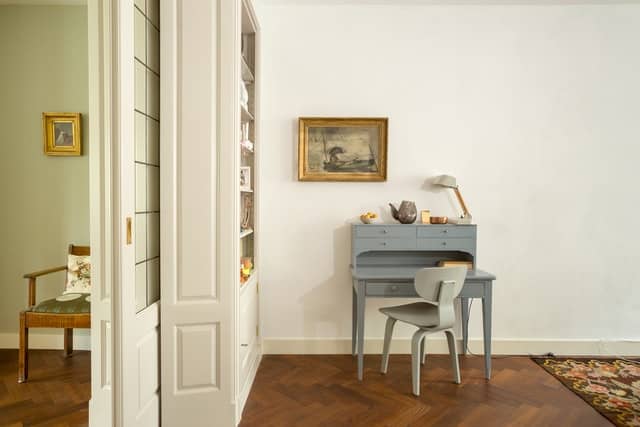
Hence, a handy office corner in the home, although more minor, will get you off your bed to find a dedicated workstation.
With a dedicated yet small and cozy corner, you will own a place to call your office.
10 Ways to Convert an Awkward Corner into a Home Office in 2024
You will find many awkward corners in your home that you can jazz up by adding a small desk, a chair, and a little lighting.
Start searching for an APPROPRIATELY AWKWARD space that might fit your home office.
Here are a few creative ideas to find and convert an awkward corner into your home office.
1. Under the Stairs Space
Use the unused space below the “Spandrel” staircase to turn it into a functional office.
If you have a staircase flanked by a wall on one side with a space left underneath, you can use it to add a small desk with an adequate workspace.
Moreover, you can use the empty wall space to create handy storage to add shelves to hold your books, office supplies, files, and lighting.
If the space is large enough, you can fit a cabinet or drawer and your desk to store your files and other work-related documents.
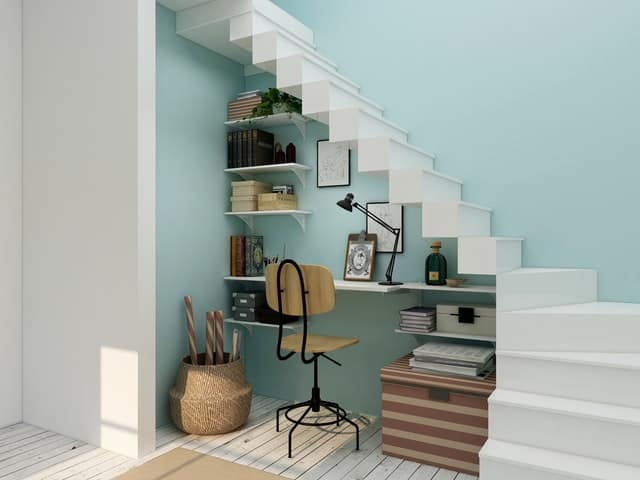
Other than setting up a desk, look into illuminating the workspace by adding hanging or wall-mounted task lighting with at least 450 lumens.
Alternatively, you can use a desk task lamp with 450 lumens, which should be enough for daily activities like writing and reading.
2. Transitional Corner in the Room
When two walls meet each other, they create a transitional corner.
Your home or apartment may have a few unused transitional spaces, such as the wall beside the window.
A space between your door and the adjacent wall or any corner between two divisions will also create a transitional corner.
However, choose an L-shaped desk to fit a big desk in a transitional corner.
If the space is smaller than you thought, you can suffice with a small rectangular table facing a single wall.
| Product | Dimensions |
|---|---|
| CubiCubi L Shape Computer Desk | Modern design, two-tier open shelves, 59.1" x 47.3" x 29.1" |
| VASAGLE L-Shaped Computer Desk | 4-shelves (two on either side), spacious tabletop, 53.9"L x 53.9"W x 29.5"H |
3. Convert an Unused Cabinet
If you have a cabinet in your room that is otherwise sitting idle, convert it into a cubicle with a functional workspace without setting up an extra room, desk, or storage space.
Alternatively, you can also convert your dressing table to a work desk.
- Add an appropriate chair with an ideal height.
- Decide the cabinet drawers you want to use for stacking your office supplies.
- If your cabinet and drawers look older and discolored, consider giving them a quick repaint to give them a pop of color.
- Repainting the cabinet is relatively easy. All you would need is a primer and paint. Otherwise, you can get a professional to do it for you.
- If the workspace seems smaller, there is not enough leg space. In this case, elongate the desk with an additional hinged countertop to fit your leg underneath and workspace above.
- The rest of the desk surface can add storage, office supplies, desk lamp, and decorations such as a photo frame or sculpture.
Voila! home office is ready.
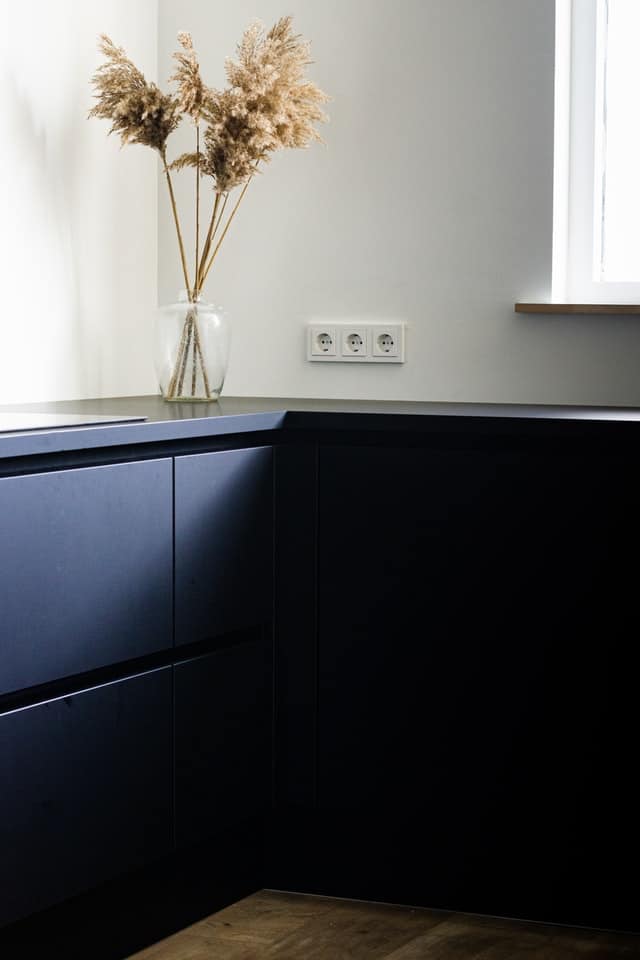
4. Convert Sandwiched Space Between Wall and Columns
Many houses have columns that otherwise occupy a significant room’s corner space.
If you have a spare space between the column and the adjacent wall in your room, consider turning it into a cozy office space.
Although limited in width, your bijou office will effortlessly fit a small desk so that you can make your workstation.
Use the adjoining wall and columns to fit deep shelves holding books, stationaries, desk lights, and office supplies.
The exciting thing about this type of office space is that your guest would never know it is your home office.
Also Read: How Much Space to Leave Between the Desk and the Wall?
5. Add a Floating Work Desk
Adding a wall-mounted work desk is a great idea to save floor space and create a mini-desk.
The space by the window or an empty wall can easily add a floating work desk.
Adding a floating work desk comes with many benefits, including
- It saves space
- Removes visual clutter
- A floating desk makes your workspace versatile
- It provides enough leg space
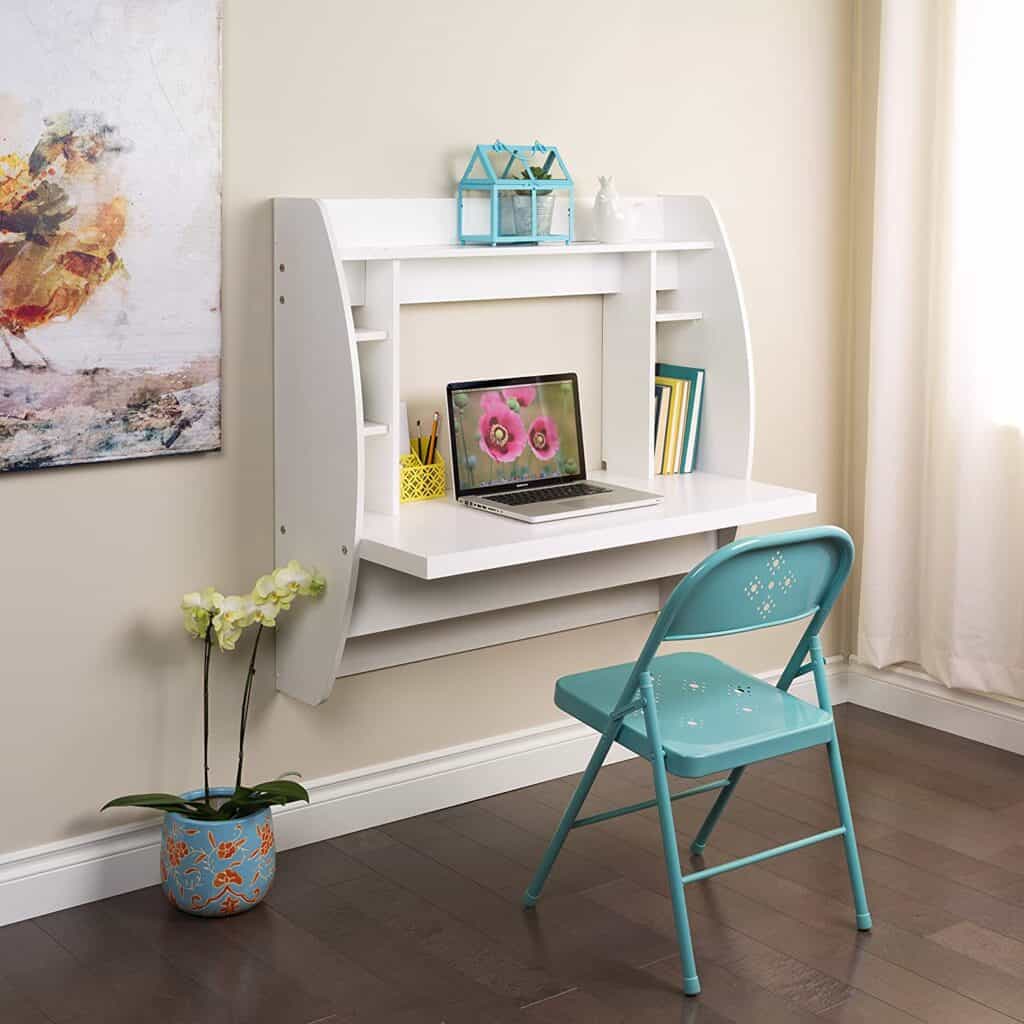
How to Install a Floating Work Desk?
- Before starting, decide on the size of the corner or wall.
- Next, have a desk surface customized to the shape.
- Ensure drilling the holes into the wall would not damage it.
- Next, install a hanging bracket to fit the desk surface.
- Attach the desk brackets over the screw holes and fasten the screws tightly.
- Lastly, assess if your floating desk can hold the adequate weight of your workspace.
Voila! You will have a floating mini-desk at your disposal.
| Product | Dimensions |
|---|---|
| Foldable and Adjustable Hanging Fold Up Desk | 38" x 20", high-quality black wood desk, laminated finish, 30 pounds |
| Grsolul Wall Mounted Folding Table | Drop-leaf style, 31.5" x 23.6", iron and wood material, 17.6 pounds |
6. Add a Corner-Pointed Desk for Tiny Corners
Consider adding a corner-pointed wall desk as the workspace and reading space for a small room with too much stuff.
Use the empty wall space to install floating shelves to keep your items that otherwise would not be possible under or beside the desk.
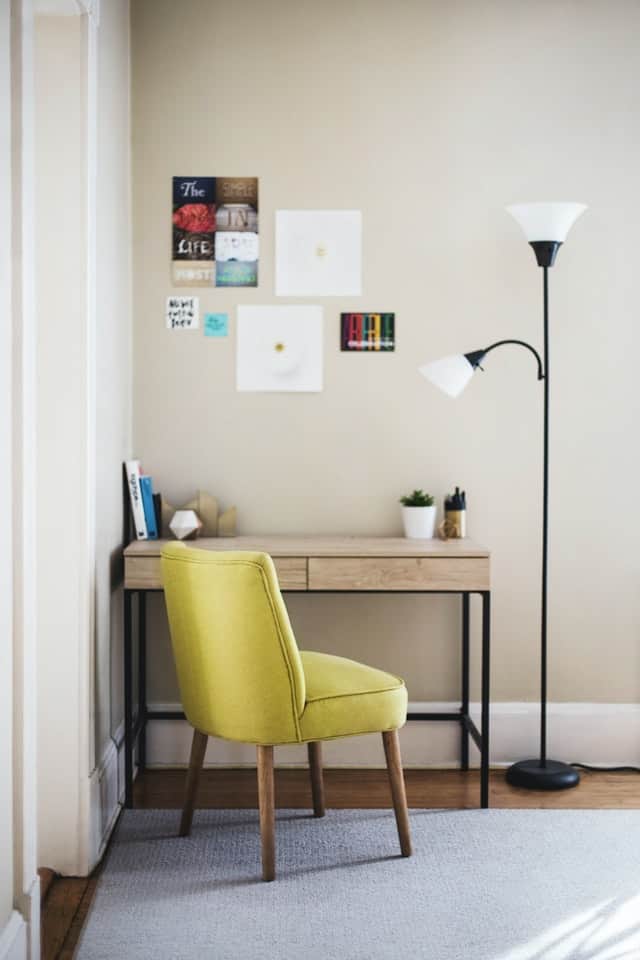
You can choose from many different corner-pointed desks made to your specification.
Consider Armocity Corner Desk Small Desk with dimensions 28.4 L x 28.4 W x 29.6 H inches, a power strip, two power outlets, and three USB ports.
Also Read: Are Corner Desks Ergonomic?
7. Utilize the Alcove
An alcove is another awkward space on the wall mainly used to add a TV screen or a table with decorations.
Make the best use of extra recess on the wall. To match its awkward dimension, consider getting a narrow, long desk that perfectly fits the alcove.
However, avoid adding a desk with zero leg space. Instead, get a desk with a hollow center.
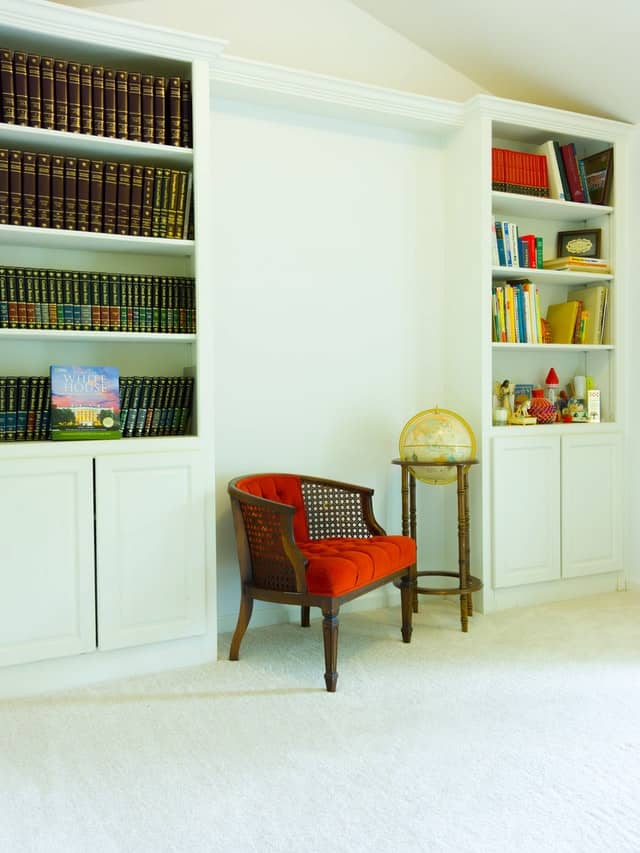
You can also add a floating desk to utilize ample leg space to spread your legs in an otherwise narrow area.
The wall recess could look too bland or minimalist for your taste. In that case, add some artwork on the wall or floating shelves on either side of the alcove to create storage.
8. Convert an Unused Kitchen Corner
Tiny homes do not have the luxury of converting an entire room into a home office, nor do they offer spare corners to fit a work desk.
However, kitchens often have a few awkward corners that you can turn into a small workstation. Consider leveling up your ample kitchen space for a home office.
Convert your meal table into a work desk, or install a small desk with minimum floor space.
One advantage of using your kitchen as the office is that you can reach for food or prepare your meal when working.
However, avoid using your kitchen as an office space if your family frequently walks in.
9. Convert Unused Hallways
One way to set up a home office for homes that do not have spare rooms or corners is by using the available hallway space.
- Consider adding a long floating desk with a narrower shelf to fit the hallways perfectly.
- Add wall-mounted task lighting or a desk lamp if the ambient lighting in your hallway is insufficient.
- Smartly use natural lighting if your hallway lies close to the window.
10. Convert Bedside Space
We all have that awkward space between the bed, door, or window, which can otherwise be turned into a home office.
Using a bedroom as a home office is the only solution if you are limited in space; thus, consider turning your lofty bedside space into a home office.
- Install an appropriately sized desk and chair.
- However, do not forget to choose the right color to complement your bedroom.
- Install a task lamp on your desk if your bedroom’s ambient lighting is insufficient.
- Use the empty wall space to add floating drawers or shelves to store your items.
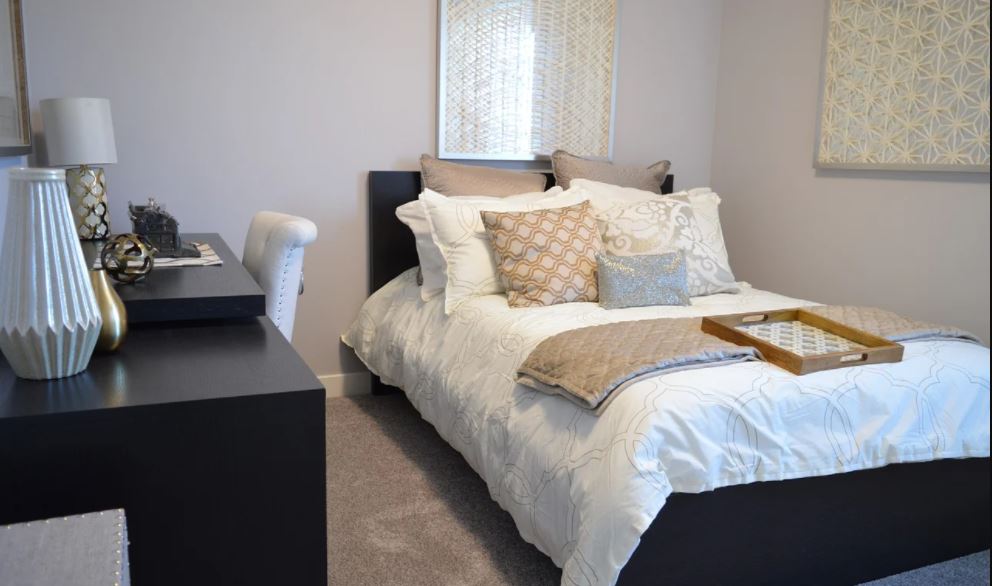
Are you thinking about placing your work desk in your bedroom? Read on to learn more about its benefits and downsides: Should you Place your Office Desk in your Bedroom?
How to Spice Up an Otherwise Awkward Corner Office?
Trying to fit many things in a small space may easily create clutter.
Working in a messy area may quickly bring your energy down and lead to a stressful situation. Hence, having an organized and decorated workspace will keep you supercharged.
Here are a few beneficial tips to spruce up your awkward office space.
1. Spice Up the Wall Color
Spruce up your awkward corner wall with an interesting touch of color.
Choosing the wall color in shades of blue, red, yellow, green, and purple helps boost your concentration level and reduce stress.
Color is essential in increasing your productivity by improving your visual experience.
Patrick O’Donnell, the color expert at Farrow & Ball, claims that,
If you want to minimize tension, choose soothing, earthy hues like greens and blues. While bright hues, such as soft whites, are ideal for creating a distraction-free environment.
When setting up your office in an awkward space, consider recoloring the walls to boost productivity without distracting you from work.

2. Use All Available Wall Wisely
For an awkward home office, the only space that you are left to decorate is the wall.
When space is limited, consider spicing up your wall by installing wall-mounted shelves.
A storage unit will provide ample space to store your books, office supplies, stationaries, decorations, houseplants, and task lamps.
Add floating shelves with compartments made from wood to add a natural appeal to your work desk.
Alternatively, you can choose from metal shelves, repurposed wood, and plastic frames.
3. Choose the Right Color Desk
Choose a desk with saturated blue, green, or red shades for a perfect-looking home workstation.
According to the Science of Color Therapy, green, red, and blue shades help to improve efficiency and focus.
Moreover, choosing a colorful desk for an otherwise awkward space will spice up the decor, giving your small desk a pop of color.

Regarding home desk color, choose from conventional red, blue, and green or more unique shades of blue-green, blue-violet, cornflower, cherry, mahogany, and ruby.
4. Add Some Greenery
Adding greenery to the work desk never goes wrong!
It enhances the decor, positively influences mood, and increases productivity.
A study by Nursery and Garden reports that adding houseplants help reduce anxiety by 37%, anger by 44%, fatigue by 38%, and depression by 58%.
Moreover, adding houseplants will help filter indoor air by reducing the intake of air toxins like Formaldehyde.
Here are a few houseplant recommendations for your awkward home office.
| Plants | Benefits |
|---|---|
| Bromeliad | They are great at removing toxic chemicals and pollutants from the air. |
| Cast Iron Plant | They are slow-growing plants that are perfect for decoration on work desks. |
| Dracaena | Bes air-purifying houseplant that helps to increase concentration |
| Pink Syngonium | Almost every Syngonium species is suitable for homes. They help cleanse air and add decor. |
| Snake Plant | They effectively cleanse benzene and trichloroethylene from the air and great low-light plants. |
| Peace Lily | A low-maintenance house plant that promotes home decor and restful sleep. |
5. Light Up Your Home Office
When setting up your home office in an awkward corner, consider using the space that receives the most natural lighting.
Natural illumination offers full-spectrum lighting, making working on a screen easier for hours.
When your home office lacks enough sunlight, consider using the best task lighting to provide adequate illumination.
Choose a low-glare, adjustable desk lamp or wall-mounted task light with at least 450 lumens to illuminate your awkwardly places home office.
6. Add Wall Art
Adding wall art is a great option to pop up an otherwise dull-looking home office.
Moreover, it is guaranteed to spice up your awkward home office corner with some creatives.
Choose from adding different frame styles with photos and artwork to create a collage.
Alternatively, you can add photo frames with pictures of your family, pet, or favorite places to enhance the wall.

7. Consider Cool Desk Accessories
Adding a few unique desk accessories will spice up your awkward home office corner.
When considering desk accessories, determine the available empty work surface and shelves to use the space best.
Adding a matching mouse pad, stationery holder, desk organizer, laptop holder, and notebook will never go wrong!
Here are a few desk accessories recommendations for you.
| Product | Specification |
|---|---|
| Nulaxy Laptop Stand | Aluminum laptop stand, 10-16" width, 7" height |
| TOZO W1 Wireless Charger | Aluminum built, supports all kinds of smartphones |
| JBL FLIP 5, Portable Bluetooth Speaker | Waterproof speaker, 12 hours of playtime |
| Wood pencil holder | Wooden pen organizer for desk with 15 compartments |
| Digital Desk Clock | Digital alarm clock, with wooden electronic LED time display |
| Wooden Desk Shelf | Adjustable desktop bookshelf desk organizer and Shelf rack counter |
8. Personalize Your Space
Personalize your work desk to give a feeling of personal space by making minor adjustments.
- Bring a photo of your family, friends, or pets on the desk.
- Choose accessories in your favorite color.
- Personalize your desktop and screensaver with your favorite photo.
- Add some more greenery if you love seeing and smelling plans when working.
- Add a BlueTooth speaker on your work desk so you can tune into your favorite songs.
Most of you spend significant time at your desk; personalizing it will encourage you to stay productive.
Also Read: How Much Space do you Need for Office Chair?
9. Add a Mirror
Although many workers may find it an unconventional choice, adding a mirror to your desk will significantly help to brighten the space and make it look bigger.
Mirrors are great at amplifying natural lighting to help illuminate the relatively dark workspace.
Along with improving lighting, it will make your work desk look significantly more prominent.
However, do not place it right before your face to avoid constant distractions.
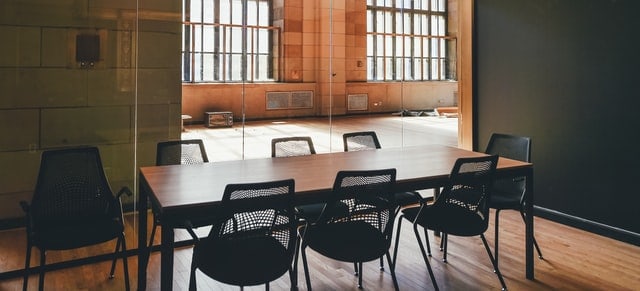
10. Fold up Your Workspace
Also known as the Fold-up Convertible Desk, it allows you to set up an instant work desk in a relatively awkward space.
They are ideally suited for rooms with inadequate space and perfectly fit as a compact cabinet on the wall.
You can unfold the cabinet and turn it into a functional desk whenever you are working.
Choose a 22″ x 32″ x 6″ fold-up desk for a small family room.
How Small is too Small for an Awkward Home Office Corner?
Not all home offices are built the same. Some vary significantly in size.
Although most home offices are 50 to 150 square feet on average, home offices built in an awkward corner will be less than 30 square feet.
You will have limited mobility, functionality, and storage space.
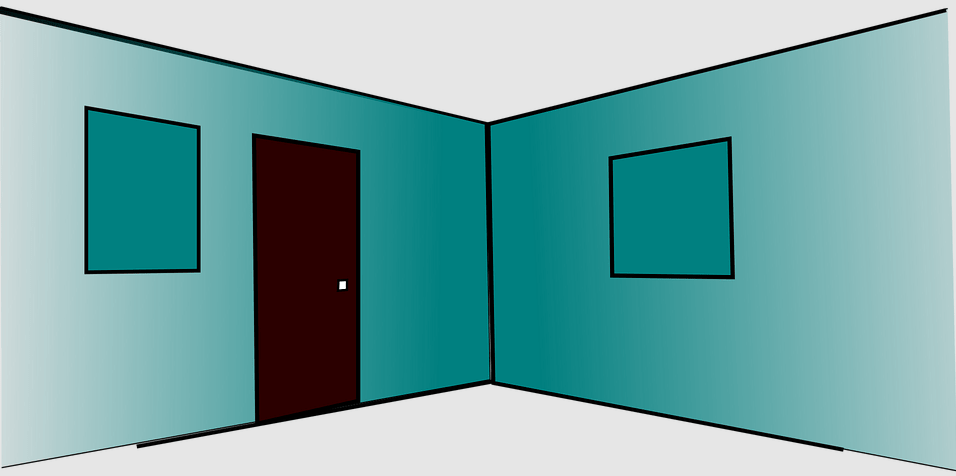
Whatever the size of your awkward home office corner is, make the best use of it by optimizing everything.
Here are a few tips to optimize your tiny home office.
- Start with making a budget for a small home office, 20 to 50 square feet.
- Consider average or small desks, a comfortable chair, and small storage to stay organized.
- Use the available space wisely by limiting the use of oversized items like printers, scanners, landlines, large monitors, etc.
- Use the wall space wisely by installing wall-mounted shelves. It will take in most of your storage items.
- Invest in good, long-lasting task lighting.
- Add leg space using a floatable office desk or desk with a hollow in the center.
Conclusion
You can get a functional and productive workstation when you plan wisely, big or small, and manageable or awkward in your home office.
When choosing a home office in an awkward corner, look into minimalism to fit everything in place without creating clutter.
More importantly, invest in good lighting when setting up an office in an awkward location because good lighting will encourage you to work more productively.
Related Article: 16 Ways to Enhance Your Home Office Desk’s Aesthetic

